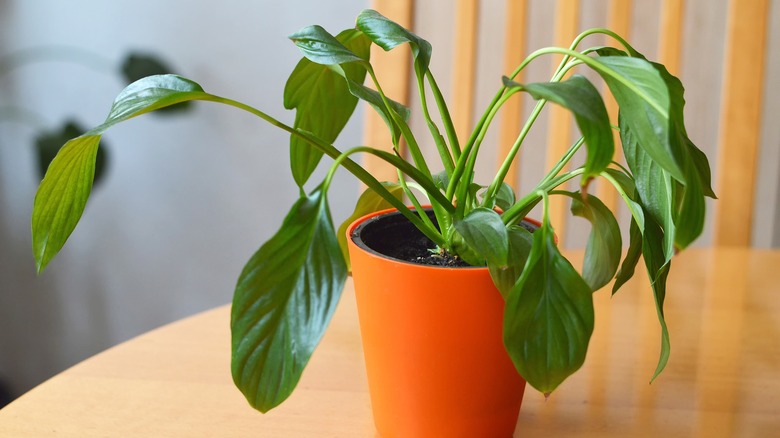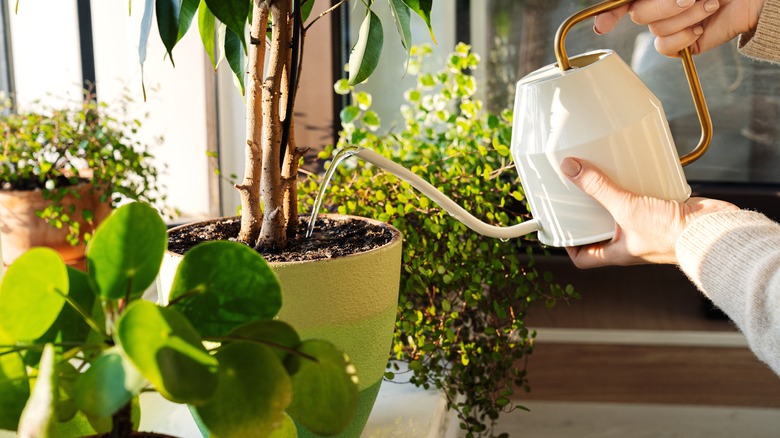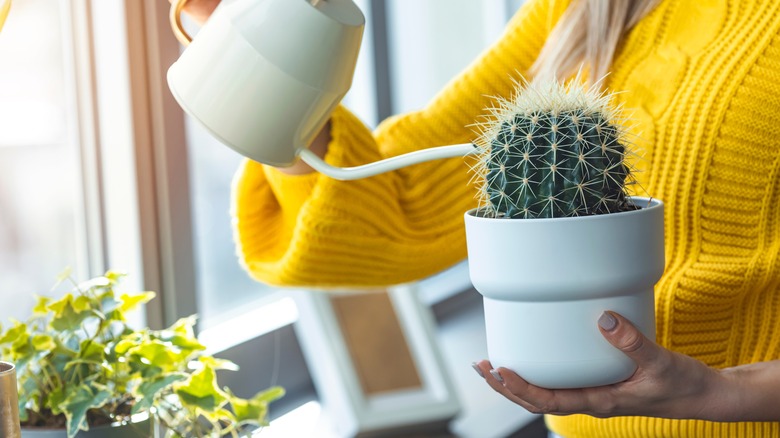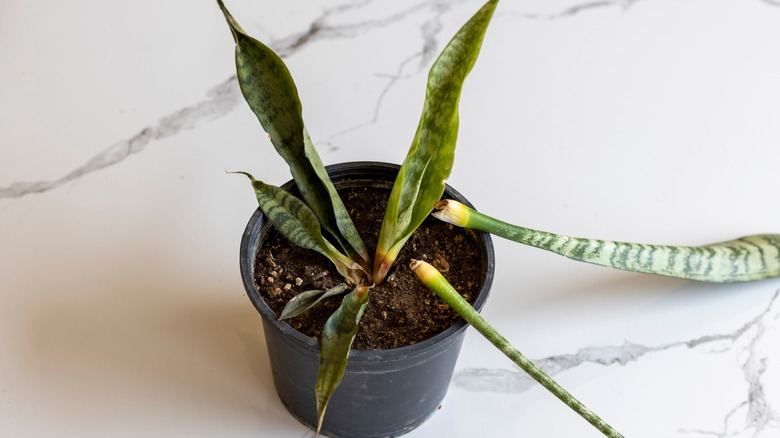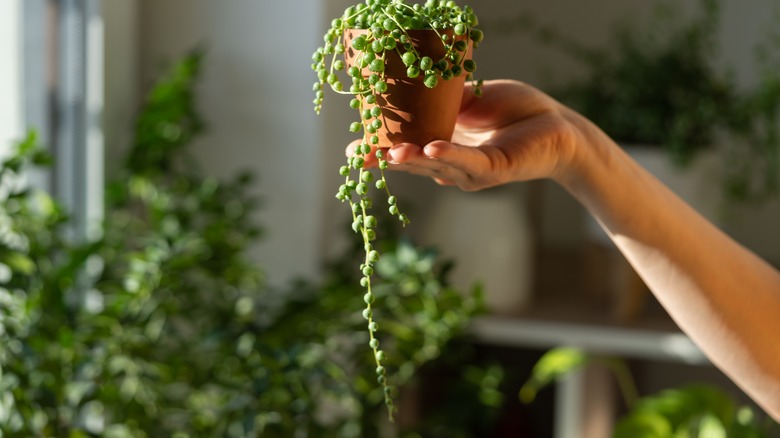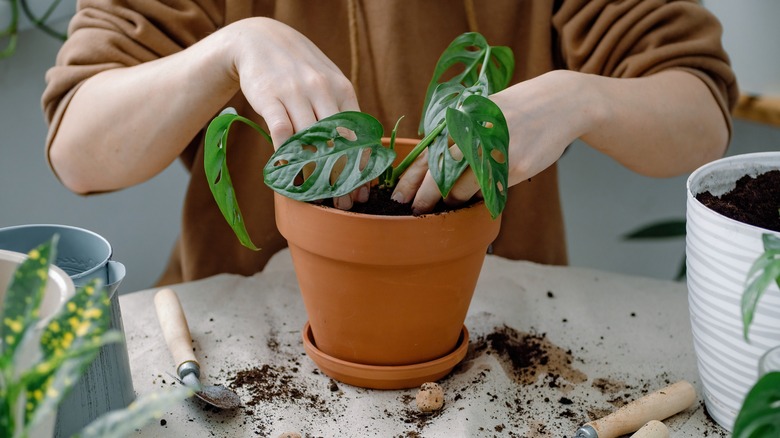Here's Why Your Plants Are Looking Dehydrated
Houseplant care and maintenance is a hobby many people take very seriously, and many care for their plants with the same attentiveness they would a pet. Plant care isn't just a passing fad, though. There are plenty of benefits to owning and caring for houseplants that make it a serious and long-standing passion for many. According to Healthline, just a few of these benefits are lower cortisol and stress levels, the alleviation of depression and anxiety, increased productivity, and better air quality.
No matter how attentive a plant parent you are, though, things happen that are out of your control. Whether it's a pest infestation, fungal disease, or other mysterious ailment, your houseplants are bound to go through periods of bad health or struggles. Knowing how to identify and resolve the issue is key to keeping them from being fatal. One common houseplant ailment is a dehydrated or thirsty plant, despite what may seem like frequent watering. Keep reading to learn how to identify common causes for thirsty-looking plants.
Underwatering
The first and most likely culprit of dry-looking houseplants is that they're simply being underwatered. Even if you think you have your plants on a steady watering schedule, it may not be nearly enough. Different houseplants require different saturation levels and frequency of watering — your hearty cast-iron plant won't need nearly as much water as your spider plant.
So, how often is enough for your individual houseplants? As noted, that entirely depends on your specific plant. According to Smart Garden Guide, a safe general tip is to wait until the soil is dry to water again. However, some plants prefer consistently moist soil conditions and require more frequent watering. Of course, obvious signs of dehydration, like wilting or crispy leaves, are a good indicator that your houseplant is thirsty, too. If your houseplant is looking underwatered, rule out the obvious first and make sure it's receiving adequate water. You can even get a moisture meter to make sure this isn't the issue at hand.
Overwatering
On the flip side, overwatering your plants can also cause them to look dehydrated, whether they're droopy and wilted or the leaves have started to get crispy. While this may seem counterintuitive, as the University of Maryland Extension explains, the extra water can't be absorbed by the soil and ends up depriving the roots of oxygen. Eventually, your plant's root system starts to reject any and all water. To make matters worse, overwatering symptoms in their early stages look very similar to underwatering.
As with underwatering your houseplants, a good tool to help you out is a moisture meter, which can ensure your plant receives the right amount of water. Also, if your plant's soil is excessively moist, it's likely being overwatered. You can test this by touching or squeezing the soil — if water comes up, it has too much to be absorbed. Heavy plants are also likely being overwatered. Consider switching your plant to a pot with more draining holes.
Root rot
Overwatering can usually be solved by easing up on the frequency at which you water your houseplants, but in worst-case scenarios, it can have lasting impacts on your houseplants. Chief among those concerns is root rot. According to Blossom, overwatering is the main cause of root rot. However, it can also be caused by fungal infections. Regardless, it will manifest as rotting roots, which deprive your plant of oxygen and water, eventually killing it.
Root rot is a pretty serious ailment, but it can be easily fixed if you catch it early enough. You'll need to remove the affected roots, so start by unpotting your plant and removing all the dirt you can from the roots. All roots look a little different houseplant by houseplant, but you can generally identify healthy roots as white or green, and firm to the touch. Rotten roots will be darker brown in color and will be squishy, slimy, stringy, and/or have a rotten smell. Using clean and sharp shears, remove all the affected roots. Then, clean out the pot with hot soapy water and replant with entirely new soil — the old soil could be contaminated, leading the root rot to redevelop.
Too much or too little sun
If you've ruled out water levels, including root rot, another potential issue could be the amount of sun your houseplant is getting. If your plant is looking a little dry, wilted, or crispy, you may be inclined to think it has to be a water or moisture issue. However, too much or too little sun can have the same visual effect.
The beginning stages of sun overexposure are wilting or drooping, which is similar to dehydration. However, the next symptoms will be burnt or curling leaves, per Plantz. While thirsty plants may have curled or dry leaves, they won't be literally scorched. If you suspect your plant is getting too much light, move it somewhere out of the direct sun, especially hot afternoon or evening direct sun. Too little light looks a little different and is easier to distinguish. According to the University of Minnesota Extension, plants in need of more light will get leggy and start to become pale, then eventually droop and drop leaves.
Bad soil
If you've ruled out all other variables, including water, moisture, disease, and lighting, and your houseplant is still looking dehydrated, the issue may be with the soil itself. Before getting your soil bag out, take a moment to research your specific plant. All plants need certain nutrients to thrive, but some need specific levels of nitrogen, phosphorus, and potassium. If these numbers are too low or high, it can lead to a sick or wilting plant. A lot of the time, your soil has simply exhausted all of its natural nutrients and has none left to offer your plant.
Another potential issue is that your soil has become hydrophobic. This can be caused by a variety of factors, but it just means your plant's soil can't absorb water anymore, per Black Dirt Company. You can tell that the soil has become hydrophobic if the water sits on top of the soil, beading or pooling off instead of soaking into the plant. You'll need to repot the plant with fresh soil to fix the issue. Add some organic matter like compost to the soil mix to help it accept water better if the issue is your bag of soil itself.
